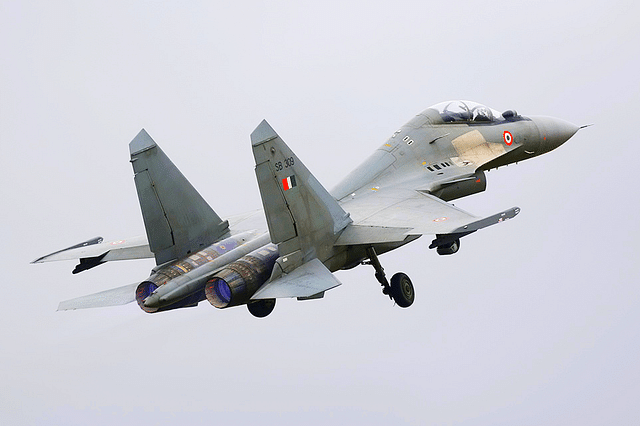
Why The Indian Air Force Should Buy More Su-30MKI Fighters
With a dwindling fleet size and uncertainty about a new deal for fighters, the Indian Air Force can’t afford to not order additional Su-30MKIs.
A series of reports in the past few months have said that the Indian Air Force (IAF) is against the idea of inducting any more Sukhoi Su-30MKIs into its fleet beyond the 272 that it had contracted for, all of which will be delivered by 2020.
These reports come at a time when the IAF’s fleet, which should ideally have 42 squadrons, is down to 31, a large part of which comprises of the obsolete MiG-21s and 27s. The service seems to have justified the push against the induction of more Su-30MKIs by saying the fighter is meant for air dominance role and is not a multi-role fighter, and its avionics, protection suite, engine and radar — all of which can be upgraded — are not fit for future needs.
While these are legitimate concerns on the IAF’s part, many arguments can be made in favour of a deal to add two to three more squadrons of the fighter to the dwindling fleet. These points come to mind:
One, a part of the Su-30MKI fleet, around 40 by some accounts, is to be modified to make it capable of carrying an air launched version of the BrahMos cruise missile, called BrahMos-A, on its belly hardpoint. The missile has been test-fired from the fighter and BrahMos is currently developing a lighter version of the missile, called BrahMos NG, three of which will be carried by a Su-30MKI. Other platforms operated by the air force are likely to get the weapons system in a single or twin missile load-out configuration, as Livefist had reported in 2017.
Structural studies performed on the fighters by Hindustan Aeronautics Limited (HAL) revealed, it was reported, “that the modifications required to make them capable of carrying the missiles are technically risky and economically unacceptable”. Modifying a Su-30MKI to make it BrahMos worthy requires reinforcing the aircraft’s underbelly and installing a heavy-duty mounting station. Therefore, instead of upgrading the fighters from the existing fleet, which have spent a part of their life and have suffered some amount of wear and tear, procuring new ones with modifications which enable them to carry the air launched versions of the missile will make more sense.
Managing director of HAL, T Suvarna Raju, has also argued on these lines.
Two, the IAF’s new effort to procure fighters, under which it floated a tender in April this year, is unlikely to move ahead in a politically charged atmosphere ahead of the 2019 Lok Sabha elections. Even when it does, price negotiations and talks over the ‘Make in India’ component of the proposed purchase are likely to take several years. Even by the most optimistic accounts, if the tender translates into a deal, deliveries will not start before 2024.
Three, HAL is not producing the Tejas aircraft fast enough. By August 2017, the HAL had delivered only three Tejas fighters to the IAF of the 20 Mark 1 fighters ordered in 2013. These aircraft were to be delivered by 2016. Additionally, the 83 Mark 1A fighters contracted for by the IAF are yet to enter production and may not roll down the assembly line before 2020. That is, if HAL sticks to the timeline. The Mark II version of Tejas, which is still on the drawing board and is likely to have capabilities that the IAF is looking for, may only be available to it after 2025.
This is how HAL’s production schedule looks like:
The HAL has projected that it will build 10 fighters in 2018-19 and 16 Tejas Mark 1As each year starting 2019-20. At this rate, the IAF may — a big may going by the PSU’s performance— have nearly 100 Tejas aircraft, in both Mark 1 and Mark 1A configuration, by the end of 2024. These would not be sufficient to replace the ageing fleet of MiG-21s and MiG-27s in the IAF which are obsolete and should have been decommissioned from service at least a decade ago. By some accounts, the IAF has around 130 MiG 21s and 27s in service. However, even if the IAF manages to replace the retiring MiGs with the Tejas fighters, which it will receive by 2024, it will continue to face the crunch as the number of squadrons will not go up with this transaction.
Again, this is when the HAL sticks to its production schedule. A miss on HAL’s part will send the IAF’s combat strengthen into a free fall starting 2020s.
In this scenario, the only addition to the number of 31 will come with the induction of two remaining squadrons of Su-30MKIs by 2020 and the arrival of two squadrons of the Rafale fighters brought in flyaway condition by 2022. The addition of these four squadrons will take the number to 35.
If the IAF places an order for additional Su-30MKIs at this time, it could add two to three more squadrons (depending on the number of fighters it orders) to its fleet, taking the number to 37 or 38 by sometime around 2023-24. The HAL is set to deliver the remaining 25 of the 272 already ordered by 2020. Given that it produces 12 Su-30MKIs a year, it can build 40 in little over three years after 2020.
Unlike the uncertainties surrounding the delivery of Tejas and the new deal for multi-role fighters, an order for additional Su-30MKIs would be a sure bet given the availability of an up and running production set up.